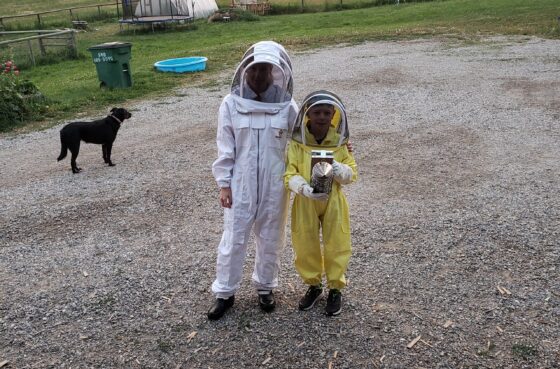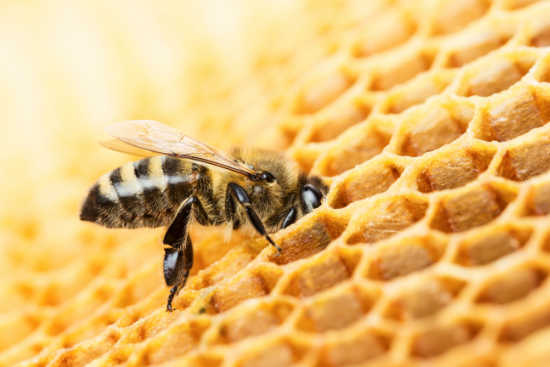We recently have begun a new adventure! We have honey bees! Because we got them so late in the season, it was recommended by other local beekeepers to “feed the bees.” But what does that mean?
It means I had to read and ask a lot of questions! Often, beekeepers only need to feed their bees during dearth (a lack of nectar and/or pollen) or in the spring to build the hive up after winter before pollen and nectar are widely available. This seems simple enough, but we had hangups. The first of which was timing. Even though we purchased our first bees on May 28th, we were unable to pick them up until July 25th! Summer was already half over at that point, but, what is still working in our favor is an unseasonably warm summer.
Luckily, I was able to remain at home while my husband went to pick up the bees 2 1/2 hours drive away. That gave me time to figure out (and make some mistakes) how to make bee food. The first thing the bees needed would be sugar syrup. When we purchased a standard Langstroth hive kit from our local Tractor Supply, it came with an in hive frame feeder with two ladders that the bees could use to get down into the food. That is what we initially used to feed the bees, but we will be switching this out as soon as Sunday because it required the removal of two frames in order to get it in the hive. That means we only had 3 bare frames after installing our 5 frame nuc. More about that later!
The Basics of Beekeeping For Beginners
Through our trials and failures, we hope to help others learn as we do. So, I recorded our first bee experiences including the making of bee pollen patties, syrup, what I did wrong, how I fixed it, and how we installed the nuc and feeder.

Timestamps:
Making sugar syrup, aka “bee food” – 1:16
Installing the frame feeder – 5:08
Installing the 5 frame nucleus – 7:45
Adding “bee patties” or pollen patties – 12:50
Adding pollen substitute -16:28 (the audio isn’t working during this section. Apologies.)
Fixing the non-flat pollen patties: 17:13
Rolling out the patties – 20:59
A sugar to water ratio of a 1:1 ratio is suggested for “bee food” for this time of year, especially in the heat. Beekeepers say any excess water will evaporate off anyway. Later in the year, if the buildup is still needed a 2:1 ratio of sugar to water is recommended. For our situation, we chose the 1:1 by the pound. I measured 6 lbs of sugar and 6lbs of water and cooked it down until it was clear. It took about 45 minutes.
After you make the sugar syrup or “bee food,” you can make pollen patties. I used whatever pollen substitute I could find at Tractor Supply. There were only two options. To make the patties, you simply mix enough pollen substitute with your sugar syrup to get a play-doh like consistency. I did not roll out the patties, which was my major mistake. When we smashed the patties under the top of the hive, the lid didn’t sit well. So I rolled out patties flat, using more of the pollen substitute as “flour” like you would do to roll out dough for human consumption. I removed the first pollen patties I put in the hive, added the flat ones, and resituated the lid so it was sitting better. (We did include this fail in the video above hoping it will help others know that you should not skip this step.)
Our bees may not need all of this extra food, however, we are trying to get the hive strong to survive winter.
We did put the dry pollen substitute on the top of the hive, but the bees have yet to touch it, so we removed it before last night’s rainstorms. We do have several flowering plants, including hollyhocks, wildflowers (lupine, western coneflower, wild geranium, etc.) catmint (catnip), thyme, and clover that the bees have available to get pollen from, and they will always choose a natural source first before resorting to the substitute. They are clever critters!
We will also be removing the in hive frame feeder and using an entrance feeder as of Sunday. We would like to use the additional two frames to help give the bees more to do and really build up their hive. Adding the two frames will increase their productivity. We need to wait until Sunday when we do our first hive inspection ever (YIKES!) to install the additional frames and the entrance feeder.
My best advice for a brand new beekeeper is to go slow around the bees, don’t panic, and know that some mistakes are going to happen when you are new to something and just learning it. Be easy on yourself. Most beekeepers are willing to help out to make sure you are a success!
This article was originally published at Ready Nutrition™ on August 10th, 2021








HI there. As a beekeeper, a few suggestions: Do not COOK your syrup. Only heat the (filtered) water briefly to “warm” to dissolve the sugar.
And ONLY use pure cane sugar. Do not use beet sugar as it is GMO and heavily sprayed with insecticides in some areas.
Best of luck with your new bees!!!!
Thanks, Debra for your recommendation!